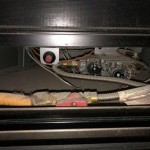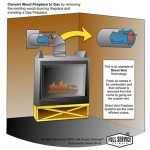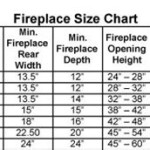Gas Fireplace Smells Like Burning Dust: Understanding and Addressing the Issue
A gas fireplace offers the convenience of instant warmth and ambiance without the mess of traditional wood-burning fireplaces. However, a common complaint among gas fireplace owners is the presence of a burning dust smell, particularly when the fireplace is first turned on after a period of inactivity. Understanding the causes behind this odor and knowing how to address it are crucial for maintaining a safe and enjoyable experience.
The "burning dust" smell is often the result of accumulated particulate matter within the fireplace unit. This matter can include actual dust, pet dander, cobwebs, and even small insects. When the fireplace is ignited, the heat causes these particles to burn, producing the characteristic odor. While the smell is generally harmless, it can be unpleasant and, in some cases, trigger allergies or respiratory sensitivities. Ignoring this issue can, over time, lead to a more significant buildup of debris, potentially affecting the performance and safety of the appliance.
Dust Accumulation on Internal Components
The primary cause of the burning dust smell is, as the name suggests, the accumulation of dust on the internal components of the fireplace. These components often include the burner assembly, logs (whether ceramic or another material), and the interior surfaces of the firebox. Due to the natural airflow within a home, dust particles are constantly circulating and will eventually settle on these surfaces. When the fireplace is inactive, this dust accumulates undisturbed. Upon ignition, the high heat quickly burns this layer of dust, creating the noticeable odor. The smell tends to be more pronounced during the first few uses of the season or after a prolonged period of inactivity.
Furthermore, the design of many gas fireplaces features intricate details and crevices that can trap dust and debris. The artificial logs, for example, often have textures and porous surfaces that readily collect particles. The burner assembly, with its small openings and intricate structure, is also prone to dust accumulation. Even the glass enclosure, if not properly sealed, can allow dust to enter and settle within the firebox. The material used for the artificial logs can also exacerbate the odor when dust burns on its surface. Some materials are more porous and absorbent than others, allowing dust and other debris to embed themselves further, leading to a more persistent smell.
Regular maintenance is essential to minimize dust accumulation. This includes periodically cleaning the interior components with appropriate tools and cleaning solutions. Specific cleaning instructions should be followed according to the manufacturer's recommendations to avoid damaging any of the sensitive parts.
Pilot Light Inactivity and Gas Odors
In some gas fireplace models, the pilot light remains lit continuously, while in others, it is ignited only when the fireplace is in use. When the pilot light is off for an extended period, a slight build-up of unburnt gas can occur within the system. While modern gas fireplaces are equipped with safety mechanisms to prevent gas leaks, a small amount of gas can still accumulate, especially if there are minor issues with the gas line or connections. When the fireplace is first ignited, this accumulated gas can burn off, contributing to the overall odor. This situation can be heightened if the gas supply has been turned off and then reactivated.
It’s important to distinguish between the burning dust smell and the distinct odor of natural gas or propane. If a strong gas smell persists even after the initial burning dust odor dissipates, it could indicate a more serious problem, such as a gas leak. In such cases, it is crucial to immediately shut off the gas supply, evacuate the area, and contact a qualified gas technician for inspection and repair. Carbon monoxide detectors are essential safety devices to have near any gas appliance. These detectors can alert occupants to the presence of carbon monoxide, a colorless, odorless gas that can be produced by incomplete combustion. Regular testing and maintenance of carbon monoxide detectors are vital.
The type of gas used (natural gas or propane) can also influence the smell. Propane, for instance, tends to have a more noticeable odorant added to it than natural gas. This added odorant is designed to make leaks easier to detect. As such, if the fireplace uses propane, any minor gas accumulation might be more readily noticeable.
Newly Installed Fireplaces and Manufacturing Residue
A burning dust smell is also common in newly installed gas fireplaces. In these cases, the odor is often attributed to the burning off of manufacturing residues, such as oils, lubricants, and protective coatings that were applied during the production process. These residues typically burn off completely after a few uses. The smell associated with these residues can sometimes be mistaken for burning dust, as the general sensation is similar, but the source is different. This smell usually diminishes significantly after the fireplace has been used a few times.
The type of materials used in the construction of the fireplace can also contribute to this initial smell. For example, the paint used on the firebox or the sealant used to seal the glass can emit odors when heated for the first time. Similarly, the packaging materials used during shipping and installation can leave residues that subsequently burn off. Ensuring proper ventilation during the initial uses of a new fireplace can help dissipate these manufacturing odors more quickly. Opening windows and using fans can assist in circulating the air and removing the fumes.
It is advisable to run a new fireplace for a few hours at a medium or high setting to allow these residues to burn off completely. During this initial burn-in period, it is crucial to monitor the fireplace closely for any unusual smells, sounds, or visual signs of malfunction. If anything seems amiss, it is essential to consult the manufacturer's instructions or contact a qualified technician for assistance.

Here S Why Your Gas Fireplace Stinks Full Service Chimney

Vent Free Fireplace Odor

Here S Why Your Gas Fireplace Stinks Full Service Chimney

Why Your Gas Fireplace Stinks Chimney Experts

Gas Fireplace Leak Symptoms What To Watch Out For Dreifuss Fireplaces

Gas Fireplace Leak Symptoms What To Watch Out For Dreifuss Fireplaces

4 Signs You Can Use Professional Gas Fireplace Maintenance

Is Black Soot From Gas Fireplace Dangerous Shepherd S

Gas Fireplace Leak Symptoms What To Watch Out For Dreifuss Fireplaces

Gas Fireplaces The Odors They Can Cause
Related Posts








